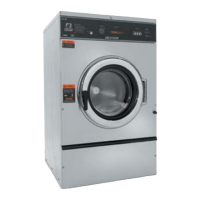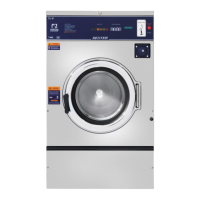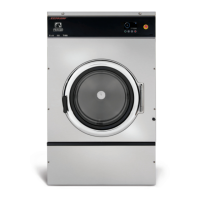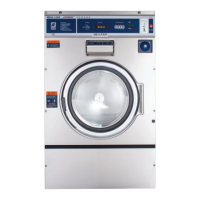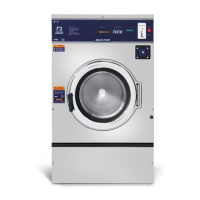Water Valves
Remove top panel to access water valves. (see Removing Top Panel) The two dual outlet water valves are
mounted to the rear channel with two screws each. Always check inlet screens to be sure that they are
clean. Disassembly requires the removal of two solenoid screws and three valve body screws. Below the
solenoid coil is a solenoid guide, armature, armature spring and diaphragm. All valve parts are available
individually or as a complete unit.
Door Lock Assembly Operation
After loading the clothing, the door should be closed and latched. The locking cam on the door contacts
the latching switch actuator which closes the latching switch. The specied number of coins should now
be added to start the washer. The solenoid pulls up on the locking pawl by use of a linkage rod. The
locking pawl has two jobs. The rst is to lock the door. This is accomplished by blocking the locking cam
on the door so that it can’t rotate to unlock. The second job is to close the two piggyback lock sensing
switches. These switches control power to all of the controls. If the door unlocks for any reason, these two
switches will stop the machine. When the door handle is 1/4 to 1/2 of an inch from its fully closed position,
the latching switch should close. The two piggyback lock sensing switches should be open when the door
is unlocked and should be closed when the door is locked.
Accessing the Door Lock Assembly
After removing the front panel and masking ring, the door lock assembly can now be accessed.
Adjustment for Door Lock Assembly
The latching switch and the piggyback lock sensing switches all have slotted mounting for easy
adjustment.
Step 1: Set door cam over pin. Here you can see
the Door CAM away from the door lock
assembly.
Step 2: Tighten spring screw on switch actuator
bracket arm until it just clears cam OD. at
base of door lock assembly.
Adjustment to this bracket usually is not
necessary as next step is used more in
eld.
49
Part # 8533-053-001 REV 4/09
Spring screwJust clear here
Switch actuator
bracket
Door cam sample
Step 4: Check for switch actuation at partial
turn of cam as in operation above. Door
handle goes from horizontal to six o’clock
vertical.
Step 3:
With switch actuator bracket adjusted you
will now need to adjust single switch by
loosening 2 at brade screws and allowing
swivel of switch. Move switch towards above
bracket until it actuates. Now tighten at
blade screws. Use a .040 thickness guage
to insert between bracket and switch and
the switch should close and open again
upon removal of thickness guage.
Step 5: Check that lock pawl arm swings to cam
lobe to lock position.
Step 6: The lock stacked switches (piggyback)
must be adjusted as door lock solonoid
pulls up on door rod and locking pawl is
now blocking door cam from turning and
is in full up position. The stacked swtiches
(piggyback) have a single actuator arm
and it must actuate when single actuator
roller wheel rolls to at side of locking
pawl. You will also notice a .040 gap
between actuator arm and switch bodies.
Note: Both stacked switches must operate
together!
50
Part # 8533-053-001 REV 4/09
Flat blade screw on
door switch latching
Door lock rod
Locking pawl blocking
Adjustment screw for
(piggyback switches)
Top of at end
of locking pawl.
Door cam
check position

